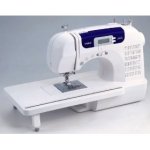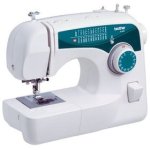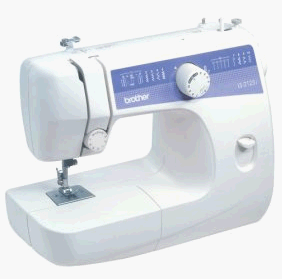Embroidery is a very expensive hobby so some people choose to buy a sewing machine that also does embroidery. But there are others who’d invest in a machine that does only embroidery and use another cheaper machine for basic sewing so that the embroidery machine suffers less wear and tear.
Which do you think is better then? If you want a 2-in-1, I recommend this Brother SE270D. It has a lot more built-in designs than the SE350, including Mickey Mouse designs, florals and other patterns, and 5 monogram fonts.

Brother SE270D Computerized Sewing and Embroidery Machine
Add More Designs with Software
You can buy more design cards or expand the database by getting a card reader and software. The software allows you to download all the designs you like from the internet. Both options are wallet-killers, but I did tell you that embroidery is an expensive hobby.
A USB port for downloading is a better option but the Brother PE700II (a pure embroidery machine) which has this feature, costs twice the price of the SE270D.
The size of the embroidery hoop is 4 by 4, not industrial size but good enough for making some nice embroidery on purses, pockets, and baby blankets, to name a few.
Good for Sewing Too
As for the sewing part, it sews pretty nicely with straight and precise stitches, and the three sewing speeds are great for beginners.
You can also adjust for long stitches if you’re doing thick or multi-layered fabrics. The automatic threading makes it very easy to switch from embroidery to sewing or to switch colors.
The Brother SE270D is very easy to use with simple controls, just right for people who’re taking on embroidery for the first time.
Further information:
Related Posts:
- Sewing Machine Review – Main
- Brother XL2600I 25-stitch Free-arm Sewing Machine – Best Basic Sewing Machine
- Singer 7442 Electronic Sewing Machine – Best Value Electronic Sewing Machine
- Brother ES2000 77-stich – Best Budget Computerized Sewing Machine
- Brother CS6000I Computerized Free-arm Sewing Machine – Best Quilting Sewing Machine
- Singer 7470 Confidence Electronic Sewing Machine – Best User-Friendly Sewing Machine
Below are the few features I feel are the most important to me when looking for a sewing machine. If you want to know how to choose the best sewing machine, click here a more detailed account.
Drop-in Bobbin
No more fumbling underneath the machine to insert the bobbin, but you can open a section right on top to drop the bobbin in. You’ll see the thread running low through a clear panel.

Automatic Buttonholer
Also called a one-step buttonholer, and is a feature that most electronic and computerized sewing machines have. Sews your buttonhole in a step without you having to turn the fabric around. Some can adjust the buttonhole size according to the button you put into a slot in the machine.

Needle Threader
Threads your needle by itself. If you have had a hard time squinting and pricking your finger in the needle-threading process, this is a life-saver. But some users didn’t like it because they are much defter than the machine.
Adjustable Presser Foot
Now you can adjust how tight the machine holds your fabric. This is important if you sew many kinds of fabric like me. Thin fabrics do not deserve the same treatment as thick ones.
Sound
Sewing machines make a certain amount of noise while sewing. Do you need to be quiet when you sew? When your baby is asleep, maybe? If that is the case, you shall have to get a sewing machine that is very quiet so that you can sew at any time of the day.
Size and Weight
Traveling around with my sewing machine is a bother, so I don’t do it. But if you need to carry it to sewing class or stow it away each time after use, the size and weight of the machine is definitely something to note. Because I sew a lot, I just cleared out a space at home specially for sewing so that I can just leave my stuff there.
Manual
The sewing machine manual is VERY IMPORTANT. Check reviews to see whether the model you’re buying has an easy understandable manual. Don’t chuck it in the box and leave it. Instead, as soon as you got your purchase, read the manual thoroughly and try it out with a few pieces of fabric.
Warranty
Sewing machines can and should last a very long time. However, always check for a warranty from the manufacturer. Most machines come with a 25-year warranty or limited warranty.
Related Posts:
- Sewing Machine Review – Main
- Brother XL2600I 25-stitch Free-arm Sewing Machine – Best Basic Sewing Machine
- Singer 7442 Electronic Sewing Machine – Best Value Electronic Sewing Machine
- Brother ES2000 77-stich – Best Budget Computerized Sewing Machine
- Brother CS6000I Computerized Free-arm Sewing Machine – Best Quilting Sewing Machine
- Singer 7470 Confidence Electronic Sewing Machine – Best User-Friendly Sewing Machine
I was a bit taken aback when I read a sewing machine manual for the first time, because I started sewing a long time ago and didn’t think of myself as a novice, but I realized that I never learned all those technical names of sewing machine parts; all my mother said when she taught me to use her ancient sewing machine was “the thread goes here and here and into here”, and “this goes inside here”.
I know that to shop for the best sewing machine you’ve got to learn those terms first, and so here they are:
Bobbin – That metallic roundish thing to hold a small spool of thread under the needle. Old sewing machines have their bobbins inserted from the underside, a small feat that would need you to lean under and peer inside if you don’t know where it goes. Nowadays machines have a small clear cover that can be opened on top for you to drop in the bobbin, and you can see whether the thread is running out.
Foot pedal – A pedal for you to press with your foot to run the machine, but some sewing machines have a start-stop button for automatic sewing too, if you’re not so good at the footwork.
Feed dog – Those teeth-like metal chains directly under the needle and presser foot, which pulls your fabric forward in a straight line when you sew. Some sewing machines allow you to drop the feed dog, so that they will go down and you can move the fabric freely in any direction while you sew.
Presser foot – That flattish piece of metal that holds your fabric flat against the needle plate when you sew. Presser feet come in a few variations for different functions, and you can change them easily because they are either screwed or clipped on.
Walking foot – A kind of presser foot that has teeth to grip the fabric together with the feed dog, usually used for quilting or sewing layers of fabrics because it keeps the fabrics from slipping, giving you a more precise stitch.
Free arm – A cylinder to help you sew pockets and sleeves.
Needle plate – The piece over the feed dogs and under the needle and presser foot. It has a hole for the needle to go through and markings to help you keep the fabric a certain distance from the needle and maintain a straight line.
For more tips of how to choose the best sewing machine and sewing machine reviews, go to my Sewing Machine Review main page.
Related Posts:
- Sewing Machine Review – Main
- Brother XL2600I 25-stitch Free-arm Sewing Machine – Best Basic Sewing Machine
- Singer 7442 Electronic Sewing Machine – Best Value Electronic Sewing Machine
- Brother ES2000 77-stich – Best Budget Computerized Sewing Machine
- Brother CS6000I Computerized Free-arm Sewing Machine – Best Quilting Sewing Machine
- Singer 7470 Confidence Electronic Sewing Machine – Best User-Friendly Sewing Machine


